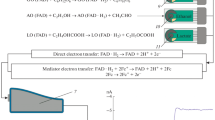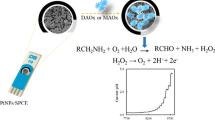Abstract.
Graphite electrodes fabricated by screen-printing have been used as amperometric detectors in biosensors based on NAD+-dependent dehydrogenases, tyrosinase, or genetically modified acetylcholinesterases. The mono-enzyme sensors have been optimized as disposable or reusable devices for detection of a variety of substrates important in the food industry (D-lactic acid, L-lactic acid, acetaldehyde) or in environmental pollution control (phenols and dithiocarbamate, carbamate and organophosphorus pesticides). The sensors were prepared in four configurations differing in enzyme confinement, enzyme immobilization and location of the immobilization agent in the biosensor assembly. Tests on real samples have been performed with the biosensors; D-lactic acid and acetaldehyde have been detected in wine and phenols in air.
Similar content being viewed by others
Author information
Authors and Affiliations
Additional information
Electronic Publication
Rights and permissions
About this article
Cite this article
Avramescu, A., Andreescu, S., Noguer, T. et al. Biosensors designed for environmental and food quality control based on screen-printed graphite electrodes with different configurations. Anal Bioanal Chem 374, 25–32 (2002). https://doi.org/10.1007/s00216-002-1312-0
Received:
Revised:
Accepted:
Issue Date:
DOI: https://doi.org/10.1007/s00216-002-1312-0




